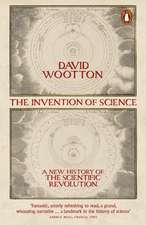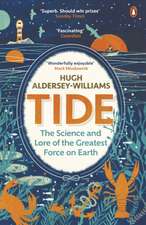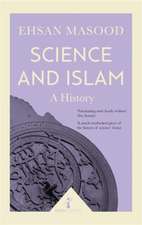Treasure Your Exceptions: The Science and Life of William Bateson
Autor Alan Cock, Donald R. Forsdykeen Limba Engleză Hardback – 7 sep 2008
Preț: 971.01 lei
Preț vechi: 1184.16 lei
-18% Nou
Puncte Express: 1457
Preț estimativ în valută:
185.81€ • 194.48$ • 154.65£
185.81€ • 194.48$ • 154.65£
Carte tipărită la comandă
Livrare economică 31 martie-14 aprilie
Preluare comenzi: 021 569.72.76
Specificații
ISBN-13: 9780387756875
ISBN-10: 0387756876
Pagini: 745
Ilustrații: XXVI, 750 p. 50 illus.
Dimensiuni: 155 x 235 x 41 mm
Greutate: 1.18 kg
Ediția:2008
Editura: Springer
Colecția Springer
Locul publicării:New York, NY, United States
ISBN-10: 0387756876
Pagini: 745
Ilustrații: XXVI, 750 p. 50 illus.
Dimensiuni: 155 x 235 x 41 mm
Greutate: 1.18 kg
Ediția:2008
Editura: Springer
Colecția Springer
Locul publicării:New York, NY, United States
Public țintă
ResearchDescriere
While aware of the works of various evolutionists in their dotage (Galton, Wallace, Weismann), initially Bateson is likely to have overlooked Hugo de Vries’ Intracellular Pangenesis. De Vries modified Darwin’s hypothesis of “pangenesis,” according the “elements,” or “pangens” that corresponded to individual characters, attributes that we now know to be those of genes. Darwin thought a character acquired during an individual’s life time, could, by virtue of the transfer of the corresponding educated pangens (gemmules), be passed on to its children. However, experiments by Galton and Heape d- proved his belief that the pangens could move from normal tissue cells to - nadal cells. Like Weismann, Galton saw the potentially immortal germ-line (stored in the ovary or testis) as distinct from the soma (the mortal remainder of the body). Since gametes remained the same size from generation to g- eration, then each parent could on average only transmit half its elements to a child, the other half being lost. This meant that there might be competition between elements for representation in future generations. “Ancestral” ch- acters that disappeared and later reappeared were due to “latent” (hidden) elements. These were distinguished from the “patent” (overt) elements that determined characters regularly seen in the offspring. Both elements were in the gametes as “primary elements. ” The latent elements constituted a “re- due” that remained after separation of “patent elements” from the primary elements. Galton downplayed the role of Darwin’s natural selection.
Cuprins
Genesis of a Geneticist.- A Cambridge Childhood (1861#x2013;1882).- From Virginia to the Aral Sea (1883#x2013;1889).- Galton.- Variation (1890#x2013;1894).- Romanes.- Reorientation and Controversy (1895#x2013;1899).- What Life May Be.- Mendelism.- Rediscovery (1900#x2013;1901).- Mendel#x0027;s Bulldog (1902#x2013;1906).- Bateson#x0027;s Bulldog.- On Course (1907#x2013;1908).- Darwin Centenary (1909).- Chromosomes.- The Innes Years.- Passages (1910#x2013;1914).- Eugenics.- War (1915#x2013;1919).- My Respectful Homage (1920#x2013;1922).- Limits Undetermined (1923#x2013;1926).- Politics.- Butler.- Pilgrimages.- The Kammerer Affair.- Science and Chauvinism.- Degrees for Women.- Eclipse.- Bashing.- Epilogue.
Recenzii
From the reviews:
"This work includes key events in Bateson’s career and is strengthened by discussion of the rediscovery of Mendelian principles by early-20th-century geneticists. … this interesting work will appeal to biologists and historians of science. Summing Up: Recommended. Upper-division undergraduate through professional collections." (J. S. Schwartz, Choice, Vol. 46 (7), March, 2009)
"The presnt book is particularly welcome in helping to fill a significant gap in the history of genetics … . Donald Forsdyke has now extended and completed the book, a major undertaking for which both geneticists and historians should be grateful." (Peter S. Harper, Human Genetics, Vol. 125, 2009)
"This volume will be of enormous benefit to historians of science who like to follow how ideas are born or die and why participants of different sides of each controversy held such rigid views of their own work and saw little merit in their competitor’s research. … I recommend reading all 745 pages of this biography. It is worth the effort … ." (Elof Axel Carlson, The Quarterly Review of Biology, Vol. 84, December, 2009)
“Cock and Forsdyke’s detailed scientific biography of Bateson is very timely. … a fascinating read and well worth the effort. It is a splendid addition to the several good historical works on genetics that have appeared in recent years and also serves as a salutary reminder that great ideas in science have a habit of being successively reborn, often in superficially different forms and guises … . serve as a pragmatic impetus for all scientists to carefully study the history of their respective fields.” (Amitabh Joshi, Journal of Genetics, Vol. 89 (4), December, 2010)
"This work includes key events in Bateson’s career and is strengthened by discussion of the rediscovery of Mendelian principles by early-20th-century geneticists. … this interesting work will appeal to biologists and historians of science. Summing Up: Recommended. Upper-division undergraduate through professional collections." (J. S. Schwartz, Choice, Vol. 46 (7), March, 2009)
"The presnt book is particularly welcome in helping to fill a significant gap in the history of genetics … . Donald Forsdyke has now extended and completed the book, a major undertaking for which both geneticists and historians should be grateful." (Peter S. Harper, Human Genetics, Vol. 125, 2009)
"This volume will be of enormous benefit to historians of science who like to follow how ideas are born or die and why participants of different sides of each controversy held such rigid views of their own work and saw little merit in their competitor’s research. … I recommend reading all 745 pages of this biography. It is worth the effort … ." (Elof Axel Carlson, The Quarterly Review of Biology, Vol. 84, December, 2009)
“Cock and Forsdyke’s detailed scientific biography of Bateson is very timely. … a fascinating read and well worth the effort. It is a splendid addition to the several good historical works on genetics that have appeared in recent years and also serves as a salutary reminder that great ideas in science have a habit of being successively reborn, often in superficially different forms and guises … . serve as a pragmatic impetus for all scientists to carefully study the history of their respective fields.” (Amitabh Joshi, Journal of Genetics, Vol. 89 (4), December, 2010)
Textul de pe ultima copertă
William Bateson brought the work of Mendel (and much more) to the attention of the English-speaking world. He commanded the biological sciences in the decades after Darwin's death in 1882. To understand these years we must first understand Bateson. Through examination of the life of a major contributor to the turn-of-the-century revolution in biology, the authors of this volume reconcile the genocentrism of George Williams and Richard Dawkins with the hierarchical thinking of Richard Goldschmidt and Stephen Jay Gould. The anti-Darwinian arguments of Bateson are only now, a century later, gaining recognition. At last, Evolutionists can present a unified front to their creationist opponents.
Caracteristici
The pressing need for this text is apparent from the high percentages reported not to believe in evolution and the growth of the so-called “intelligent design” movement
So far biohistorians have failed to come up with a comprehensive biography of William Bateson. In 1986 William Provine concluded: “Evolutionary biology in the period 1859-1925 is extraordinary complex”. To understand this period we must understand Bateson
Many books of this nature are written by historians of science who are often able to provide an attractive narrative, but are less able to untangle the more controversial aspects of the science. The present book is written by two “card carrying” bioscientists who, relatively late in their careers, turned to biohistory while remaining at the “cutting edge” of their disciplines. For several decades the Bateson papers languished in the attic of an outhouse at Hancock in New Hampshire, until “repatriated” by Alan Cock in 1975 with the help of Stephen Jay Gould
So far biohistorians have failed to come up with a comprehensive biography of William Bateson. In 1986 William Provine concluded: “Evolutionary biology in the period 1859-1925 is extraordinary complex”. To understand this period we must understand Bateson
Many books of this nature are written by historians of science who are often able to provide an attractive narrative, but are less able to untangle the more controversial aspects of the science. The present book is written by two “card carrying” bioscientists who, relatively late in their careers, turned to biohistory while remaining at the “cutting edge” of their disciplines. For several decades the Bateson papers languished in the attic of an outhouse at Hancock in New Hampshire, until “repatriated” by Alan Cock in 1975 with the help of Stephen Jay Gould











